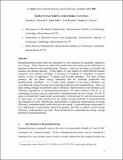Remanufacturing and Energy Savings
Author(s)
Gutowski, Timothy G; Sahni, Sahil; Boustani, Avid; Graves, Stephen C
DownloadAccepted version (1.629Mb)
Open Access Policy
Open Access Policy
Creative Commons Attribution-Noncommercial-Share Alike
Terms of use
Metadata
Show full item recordAbstract
Remanufactured products that can substitute for new products are generally claimed to save energy. These claims are made from studies that look mainly at the differences in materials production and manufacturing. However, when the use phase is included, the situation can change radically. In this Article, 25 case studies for eight different product categories were studied, including: (1) furniture, (2) clothing, (3) computers, (4) electric motors, (5) tires, (6) appliances, (7) engines, and (8) toner cartridges. For most of these products, the use phase energy dominates that for materials production and manufacturing combined. As a result, small changes in use phase efficiency can overwhelm the claimed savings from materials production and manufacturing. These use phase energy changes are primarily due to efficiency improvements in new products, and efficiency degradation in remanufactured products. For those products with no, or an unchanging, use phase energy requirement, remanufacturing can save energy. For the 25 cases, we found that 8 cases clearly saved energy, 6 did not, and 11 were too close to call. In some cases, we could examine how the energy savings potential of remanufacturing has changed over time. Specifically, during times of significant improvements in energy efficiency, remanufacturing would often not save energy. A general design trend seems to be to add power to a previously unpowered product, and then to improve on the energy efficiency of the product over time. These trends tend to undermine the energy savings potential of remanufacturing.
Date issued
2011-05-15Department
Massachusetts Institute of Technology. Department of Mechanical Engineering; Massachusetts Institute of Technology. Department of Materials Science and Engineering; Sloan School of ManagementJournal
Environmental Science & Technology
Publisher
American Chemical Society
Citation
Gutowski, Timothy G., et al. "Remanufacturing and Energy Savings." Environmental Science & Technology 45 10 (2011): 4540-47.
Version: Author's final manuscript